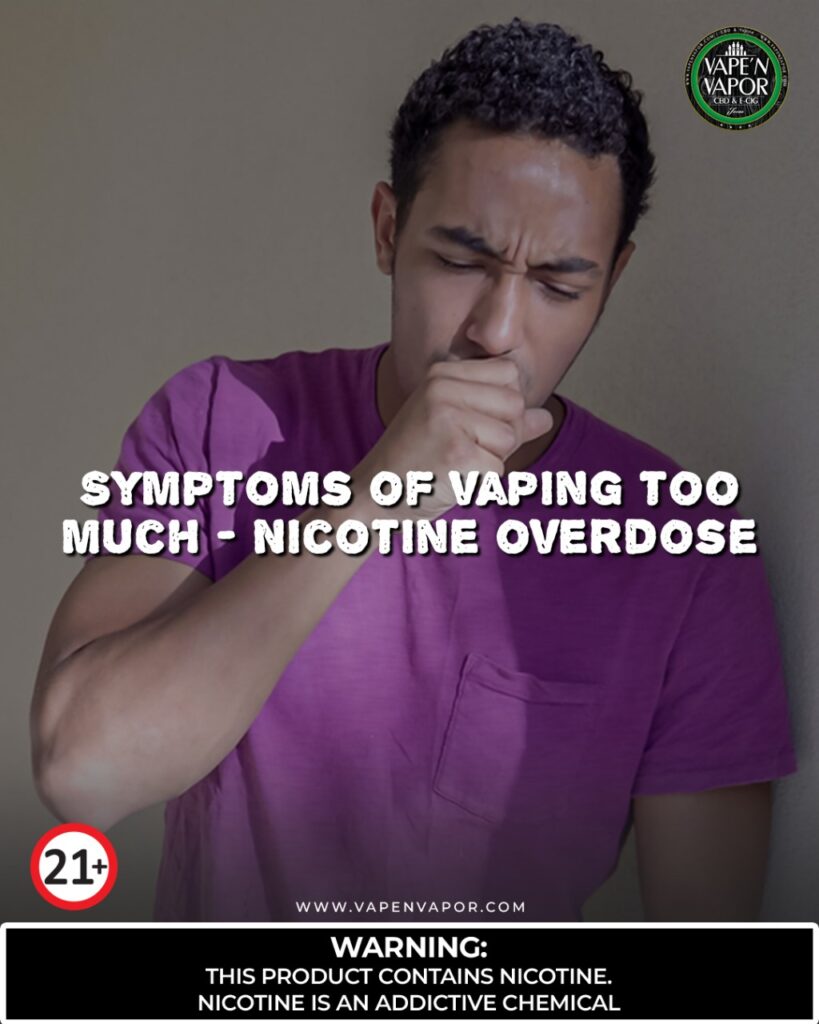Symptoms Of Vaping Too Much – Nicotine Overdose

The rising craze for electronic cigarettes, or vapes, has exposed an entirely new generation to nicotine. The extremely addictive substance present in tobacco, nicotine, is known to be delivered in concentrated doses via vapes. Vapes are now promoted as a “cleaner” option to conventional cigarettes.
A really important question is brought up by this whole thing: what happens if you vape too much? Is it possible to overindulge in nicotine, and if so, what are the telltale signs? You may find the answers to all of these queries in this post. Now let’s get going!
Understanding Nicotine Overdose and Intoxication
When too much nicotine enters your body, it can cause a nicotine overdose, which is also known as nicotine intoxication. This may occur by skin absorption, ingestion, or inhalation. Because vaping makes it simple to consume big amounts of nicotine quickly, there is a heightened danger associated with it.
The age, weight, and individual tolerance are some of the parameters that determine the deadly dosage of nicotine. However, the suggested amount for a healthy adult is 60 mg. Although this may sound excessive, it’s really quite easy to consume a deadly quantity of nicotine because refillable vapes may contain much greater concentrations, and some Juul pods have as much as 59 mg per milliliter (nicotine overdose Juul).
What are the dangers associated with nicotine overuse?
The risks associated with excessive vaping are evident, even if they don’t necessarily result in a full-blown overdose. Many unpleasant and sometimes dangerous side effects can result from excessive nicotine consumption.
The early warning signs of nicotine overdose
After a nicotine overdose, the early warning signals appear between 15 and 60 minutes later. The beginning of it all is nausea and vomiting. This is a result of the poison being eliminated by your body as a natural defensive mechanism. Diarrhea and upset stomach are indicative of the second warning sign because nicotine affects the digestive tract. Another early indicator of nicotine misuse is elevated blood pressure and heart rate since nicotine is a stimulant that strains the heart.
Because smoking alters blood flow to the brain, you may also experience headaches and dizziness more frequently. Excessive sweating and salivation are very common signs of nicotine overuse. These are due to the disruption of your nervous system. Additionally, you can observe tremors and muscle weakness in your body. Proper muscular function is impeded by nicotine use. Finally, you will feel more anxious and confused since nicotine might change your mood and cognitive abilities.
Later Signs
If you don’t get treatment for your abuse of nicotine, you will eventually show symptoms. Among these symptoms is trouble breathing, as nicotine paralyzes muscles involved in breathing. Seizures are another prevalent later symptom of excessive nicotine usage. This is due to the fact that acute nicotine overdose may result in brain electrical disruptions.
The body will attempt to offset the first stimulus by slowing down your respiration and pulse rate. A coma is the deadliest and most severe symptom of excessive nicotine use, and it can even be fatal. It’s critical to understand that, if left untreated, a nicotine overdose can be lethal.
Nicotine Addiction and the Cycle of Overuse:
Vaping can quickly result in nicotine dependency since nicotine is a very addictive substance. As a result, there is a danger of nicotine overdose as users may become addicted to vaping in an attempt to sate their demands for the stimulating effects of nicotine.
Even though the previously described symptoms might aid in self-diagnosis, it’s important to recognize the warning indications of nicotine overdose in others, particularly in young adults and children. It is strongly advised that you contact emergency authorities right away if you think someone has overdosed on nicotine. Try counseling them if you believe the symptoms are indicative of an early overdose. Pro-active behavior is always preferable to reactive behavior.
The best defense against nicotine overdose and the risks that go along with it is to stop vaping. Fortunately, your body begins to mend the moment you give up. Your blood pressure and heart rate will return to normal in a few days, and your breathing will become better. Though it might be difficult to stop, there are tools available to support you.
Do not be afraid to ask for assistance if you have concerns about your vaping habits or believe you may have overdosed on nicotine. Speak with your doctor first, as always. In addition to evaluating your symptoms, they can offer advice on how to stop vaping. You should also think about resources for quitting smoking. While there are several tools available to assist individuals in quitting smoking, it’s important to remember that they are not the same.
Vaping vs. Smoking
It’s important to dispel the myth that vaping is a completely safe alternative to smoking. While cigarettes contain a multitude of harmful chemicals beyond nicotine, vaping exposes users to concentrated nicotine alongside other potentially risky substances. The long – term health effects of vaping are still under investigation, but research suggests it can damage the lungs, heart, and brain.
Cigarettes are a toxic mix of over 7,000 chemicals, with most of them leading to causing cancer. Tar coats lungs, hindering their function, while carbon monoxide steals oxygen from the bloodstream. Nicotine, being the addictive chemical, raises blood pressure and weakens the immune system. The list of smoking – related illnesses is long, lung cancer, heart disease, and more.
Vaping, however, appears to be less harmful. E – cigarettes heat a liquid (e – liquid) containing nicotine, flavorings, and other chemicals, creating an inhaled vapor. This eliminates tar and carbon monoxide, a clear advantage. However, it is worth considering that vaping isn’t free of risks.
The full picture on vaping’s health effects is still developing, but concerns are mounting. E – liquid can contain harmful chemicals like diacetyl, linked to lung disease, and heavy metals that damage the brain. Propylene glycol and vegetable glycerin, common ingredients, may have unknown long – term effects.
Vaping itself irritates the lungs, causing coughing and shortness of breath. The nicotine delivers the same health risks as in cigarettes – addiction, increased blood pressure, and a weakened immune system.
All in all, vaping’s appeal lies in its lack of smoke odor and its variety of flavors, especially attractive to young people. This ease of use can lead to increased nicotine dependence, even in non – smokers. Additionally, the impact of nicotine exposure on the developing brain is a major concern.
While vaping may be less harmful than smoking, it’s not a safe alternative. Both expose users to a range of chemicals that can damage their health. The lack of long – term data on vaping adds another layer of uncertainty.
The bottom line is, avoid both. If you smoke, quitting is the single best decision for your health. Numerous resources and support groups are available to help. If you’re considering vaping, be aware of the potential dangers and explore healthier alternatives. Make your choice based on facts, not a clouded perception.
The rise in teen vaping is a particular cause for concern. Nicotine addiction can hinder brain development in adolescents, impacting memory, learning, and attention. Additionally, the flavors and design of many vape products are specifically targeted towards young people.
We have some tips to help protect young people from the dangers of vaping. First is open communication. Talk to your children about the risks of vaping and nicotine addiction. If you take direct action, it might lead to them being rebellious about it. Be a positive role model. If you vape, consider quitting to set a good example. Lastly, support anti – vaping initiatives. Advocate for policies that restrict access to vaping products by minors.
Final Thoughts
Vaping always comes across “cleaner” alternative to smoking. While it does eliminate tar and carbon monoxide, it also exposes users to a different set of risks. The long – term consequences of inhaling unknown chemicals and flavored e – liquids are uncertain.
It goes without saying that vaping delivers the addictive punch of nicotine. But it also raises your blood pressure and weakens your immune system. The ease of use and variety of flavors can hook young people, potentially hindering brain development. This is particularly concerning as the crucial window for cognitive growth coincides with their peak vulnerability to peer pressure.
The best course of action is to avoid both smoking and vaping. If you’re a smoker, quitting is the ultimate gift to your health. Numerous resources and support groups are readily available to help you on this journey. For those considering vaping, explore healthier alternatives and base your decisions on facts, not misleading perceptions.
Protecting young people requires a multi – pronged approach. Open communication about the dangers of vaping is paramount. Parents who vape should strive to quit, setting a positive example. Supporting anti – vaping initiatives and advocating for policies that restrict access to minors are crucial steps towards safeguarding their health.
All in all, vaping is not a safe haven for smokers. It’s a detour on the path to a healthier you. Choose clean air over flavored clouds – your future self will thank you.
